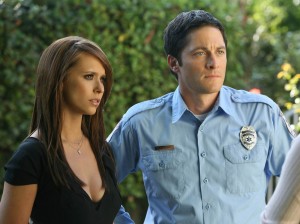Friday, June 20: Bandersnatches
ON A GENDER ROLL
by Steve Steinbock
I’ve been enjoying the discussion, led by my criminal colleague Leigh Lundin for the past three weeks, on male/female differences as applied to fiction writing. A few days ago Melodie joined the discussion with her own High-Heeled observations. Today I’m jumping on the gender bandwagon just because. We’re on a roll. Or is it role?
This subject has been on my mind. I’ve been reading a book called Why We Read Fiction: Theory of Mind and the Novel by Lisa Zunshine. It’s a fascinating book, and she gives equal time to detective fiction (Hammett, Christie, Grafton, etc.) as she does to Virginia Woolf and Jane Austen. Zunshine’s premise, reduced by me to a sound-byte, is more or less that we read fiction because we enjoy interpreting, empathizing, and interacting with the emotions of the characters. (There’s a lot more than that. That is just my ten cent summary).
Professor Zunshine’s book directed me to Simon Baron-Cohen (first cousin to “Borat” star Sacha Baron-Cohen), whose The Essential Difference: Male and Female Brains and the Truth about Autism. The Cambridge University professor of psychiatry posits that women’s brains are “predominantly hard-wired for empathy,” while men’s are “predominantly hard-wired for understanding and building systems.”
Baron-Cohen is making generalizations, and so am I. My hypothesis is that the absence of a Y-chromosome sways (female) writers to emphasize human interaction, while writers with a Y-chromosome (i.e. males) are inclined to write stories that emphasize action and ideas.
The corollary of this is that male readers tend toward action and idea filled books, while female readers tend toward books that are heavy on emotional development and interaction of characters.
 Like the friend Leigh mentioned in part two, I’ve watched my share of Ghost Whisperer episodes and I freely admit that I watch it for Jennifer Love-Hewitt’s cleavage, but one thing I’ve noticed throughout is that the character of Melinda’s husband — good-looking, romantic, and understanding paramedic — is even less believable than the ghosts. He’s not a real man. He’s a woman’s fantasy of a man. Which got me thinking, fictional characters aren’t real people — they’re fictional. But they do have to fit the target audience’s image — or ideal — of real people. Just like Leigh’s EXAMPLE 1 of unrealistic male characters, it may be improbable, but it’s what many readers want.
Like the friend Leigh mentioned in part two, I’ve watched my share of Ghost Whisperer episodes and I freely admit that I watch it for Jennifer Love-Hewitt’s cleavage, but one thing I’ve noticed throughout is that the character of Melinda’s husband — good-looking, romantic, and understanding paramedic — is even less believable than the ghosts. He’s not a real man. He’s a woman’s fantasy of a man. Which got me thinking, fictional characters aren’t real people — they’re fictional. But they do have to fit the target audience’s image — or ideal — of real people. Just like Leigh’s EXAMPLE 1 of unrealistic male characters, it may be improbable, but it’s what many readers want.
 Lawrence Block’s “Chip Harrison” novels are the male counterparts to women’s romance novels. More recent examples are the “John Blake” novels by Charles Ardai (under the pseudonym Richard Aleas). Nubile women don’t normally lose their underwear or throw themselves at men like they do in every chapter of these novels. But it makes for interesting reading.
Lawrence Block’s “Chip Harrison” novels are the male counterparts to women’s romance novels. More recent examples are the “John Blake” novels by Charles Ardai (under the pseudonym Richard Aleas). Nubile women don’t normally lose their underwear or throw themselves at men like they do in every chapter of these novels. But it makes for interesting reading.
Why should readers care whether Elizabeth gets together with Mr. Darcy? They’re not even real people. But countless readers of Pride and Prejudice do care. And a majority of these are women. Likewise, Janet Evanovich’s books don’t sell because of the intricate plotting. People come back to her books because they care about Stephanie Plum.
On the other hand, no one reads Tom Clancy or Clive Cussler because of an emotional attachment to Jack Ryan or Dirk Pitt.
One last observation: in comment #11 to Leigh’s third column on gender, our dedicated community member Alisa mentioned, “yet another vice we women have – fixing things!!” I’d like to qualify that. It’s men who feel compelled to fix things. That’s why we are always tinkering with cars and computers, and why when women are upset about something, we make the mistake of trying to fix the problem rather than simply understanding it. The things that women want to fix tend to be relationships.




















Great ideas, Steve. I think Baron-Cohen, like Melodie, has a substantial point. In recent fiction, I think Michael Crichton had one of the most brilliant premises ever, that it was possible to extract DNA from a prehistoric mosquito trapped in amber. This is nowhere near the top of the list for what most women would consider a novel premise. Neither of us is right– or wrong– but different. And yet, no matter what is uppermost, at another level men do channel emotions just as women channel ideas.
Like most men, I never seem to learn that when women are upset with someone/something, they don’t want their man to fix it, they want sympathy, the opposite of what a man would want. This ties into my two key motivations for men:
1. Males need to protect loved ones.
2. Males need to feel heroic.
When it came to women falling naked at the feet of men, the Our Man Flint movie was so over the top, a parody of a parody, that it stuck in the craw of most men and women alike. Men fantasize– and women fantasize– but the reality, perhaps fortunately, is different. An old girlfriend said, “It’s often better you didn’t and wish you had.”
The idea behind Jurassic Park wasn’t original with Michael Crichton. He got it from controversial paleontologist Charles R. Pellegrino, who suggested it to him during a stroll on the beach.
I am very glad you clarified that “fixing things” because I’ve always thought I shoulda been a boy person because of my love of and involvment in sports. However, puttering with cars is not my thing. If it doesn’t start when the key turns, the cell is a great invention for all man(and woman)kind.
Here’s the deal. All women loved the ever sparring Rhet and Scarlett. When he whisked her into his arms and walked determinedly up the stairwell and gallantly carried her into the bedroom….and in both book and movie,,,,,slammed the door in our faces. Women and men loved it because it was in character to both and yet each gender could see themselves and “their role.”
Men may well wonder why women all over the world swooned, drooled and sighed. In excess anyway. Not me, I have a great imagination!
I was also a big Errol Flynn, Tyrone Power, Dana Andrews, Richard Widmark, Claudette Cobert, Bette Davis, Rita Hayworth, etc fan because my mother loved those type books and movies.
Action! Romance! Daring! Defying! All wrapped into a book or movie.
These days everything has gotten so graphic my imagination has suffered a giant lapse because, not one to miss one word in a book or one scene in a flick, I’m going, did I really see/read that? Thank goodness for TIVO. Yep….I did.
So. What used to be was what men and women could understand and tolerate and see themselves doing/being. In today’s world, most (of us old pharts anyway) are thinking there’s no way in you-know-where that could really happen. Could it?
Way too much information these days. Thats why I like to be “a part of the book” or “in the movie”—the things I could do, or my hero could do. y’know?
Back to “fixing things”—I haven’t found a wifey for ADD yet.
Enjoyed your article.
My wife says I always stop while channel-surfing to check out any program that involves either a ballgame or a shootout, and I maintain that she pauses on any show that features a woman crying–and if more than one woman is crying at the same time, that’s a definite bonus.
By the way, how could one not take Ardai’s novels seriously?–His pseudonym is Aleas!!
John, in my house it’s definitely my wife who holds the TV remote. Regarding Charles Ardai’s pseudonym, if you look carefully, RICHARD ALEAS is an anagram for CHARLES ARDAI. I think that’s pretty clever.
Various volumes of the Hack Writers Library are attributed to by-lines of Jason Ewan R. R. McNeill, Anne J. Cromwell-Rains, Lawrence J. Marlinson, Nicol Mesala Wrenn Jr., A. M. Jenner-Cornwallis, and Jewell Norris Canman—whose names, by a concatenation of astonishing coincidences, all have exactly the same letters as “James Lincoln Warren”.
But the volumes so attributed were actually all written by Keith Snyder, with a few words changed from his original Guide to Writing Mysteries.
Boy, James, I envy you your variety of possible acronym/pseudonyms. The best I have ever come with for my own is Lorrie B. Potters.